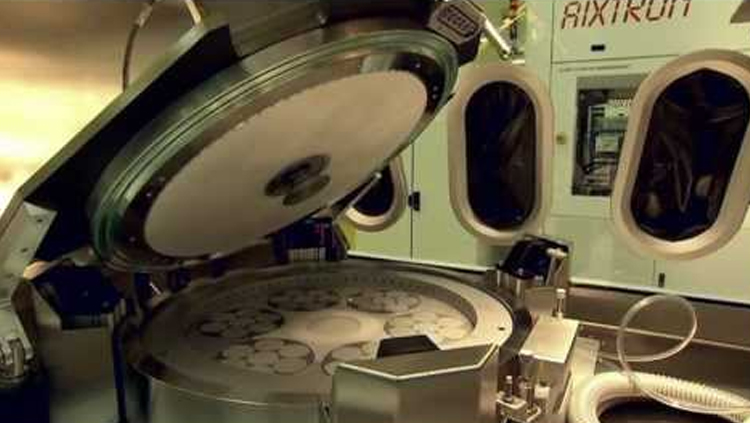News Article
Researchers make full-colour InGaN LEDs using LCD-type process
Low cost pulsed sputtering technique shows promise for large area InGaN LED displays
InGaN-based LEDs are now widely accepted as highly efficient light sources that can replace incandescent bulbs. But so far they been limited to small devices. Now a team from the University of Tokyo has shown that InGaN LEDs could form large area displays on amorphous substrates using a manufacturing technique frequently used for making liquid-crystal displays (LCD).
To date, most InGaN-based LEDs have been fabricated using expensive MOCVD processes on single-crystal substrates such as sapphire and SiC.� In contrast, the Tokyo team used a pulsed sputtering deposition process to grow GaN and InGaN films on amorphous SiO2. They made
working red, green, and blue InGaN LEDs.

Many attempts have been made to replace single-crystal substrates for the growth of group-III nitrides with low-cost, large-area materials such as glass and metal. Glass is the ideal substrate for large-area, low-cost LEDs because of its transparency and compatibility with existing LCD fabrication processes. But GaN films grown on glass have been impractical due to a low softening temperature (500-700degC) for glass substrates, and the amorphous nature of glass, which leads to poor crystalline quality of the overlaid nitride semiconductor layer.
By introducing multilayer graphene as a highly oriented crystalline buffer layer between the substrate and nitride film, the team overcame the first problem (large-area graphene films like these can be easily deposited by conventional chemical vapour deposition). As for the low softening temperature, recent progress in the epitaxial growth techniques based on pulsed sputtering deposition enables the growth of high-quality group III nitride crystals even at room temperature. The successful reduction in the growth temperature was achieved because of the high kinetic energy and pulsed supply of group III atoms, which assist the surface migration of film precursors at substrate surfaces, Recently, successful fabrication of 640 nm InGaN LEDs by PSD at a maximum process temperature of 480degC has been reported� (Nakamura et al Appl. Phys. Lett. 104, 051121 (2014)).
By demonstrating that full-color LEDs can be fabricated on amorphous substrates, the researchers think that since sputtering is frequently used in the LCD industry, it could be adapted to fabricate large-area inorganic LED displays on glass substrates including flexible glass foils.
This work is detailed in the paper Fabrication of �full-colour InGaN-based Light-emitting diodes on amorphous �substrates by pulsed sputtering by
Jeong woo Shon et al in Nature Scientific Reports 4, Article number 5325
To date, most InGaN-based LEDs have been fabricated using expensive MOCVD processes on single-crystal substrates such as sapphire and SiC.� In contrast, the Tokyo team used a pulsed sputtering deposition process to grow GaN and InGaN films on amorphous SiO2. They made
working red, green, and blue InGaN LEDs.

Many attempts have been made to replace single-crystal substrates for the growth of group-III nitrides with low-cost, large-area materials such as glass and metal. Glass is the ideal substrate for large-area, low-cost LEDs because of its transparency and compatibility with existing LCD fabrication processes. But GaN films grown on glass have been impractical due to a low softening temperature (500-700degC) for glass substrates, and the amorphous nature of glass, which leads to poor crystalline quality of the overlaid nitride semiconductor layer.
By introducing multilayer graphene as a highly oriented crystalline buffer layer between the substrate and nitride film, the team overcame the first problem (large-area graphene films like these can be easily deposited by conventional chemical vapour deposition). As for the low softening temperature, recent progress in the epitaxial growth techniques based on pulsed sputtering deposition enables the growth of high-quality group III nitride crystals even at room temperature. The successful reduction in the growth temperature was achieved because of the high kinetic energy and pulsed supply of group III atoms, which assist the surface migration of film precursors at substrate surfaces, Recently, successful fabrication of 640 nm InGaN LEDs by PSD at a maximum process temperature of 480degC has been reported� (Nakamura et al Appl. Phys. Lett. 104, 051121 (2014)).
By demonstrating that full-color LEDs can be fabricated on amorphous substrates, the researchers think that since sputtering is frequently used in the LCD industry, it could be adapted to fabricate large-area inorganic LED displays on glass substrates including flexible glass foils.
This work is detailed in the paper Fabrication of �full-colour InGaN-based Light-emitting diodes on amorphous �substrates by pulsed sputtering by
Jeong woo Shon et al in Nature Scientific Reports 4, Article number 5325


































